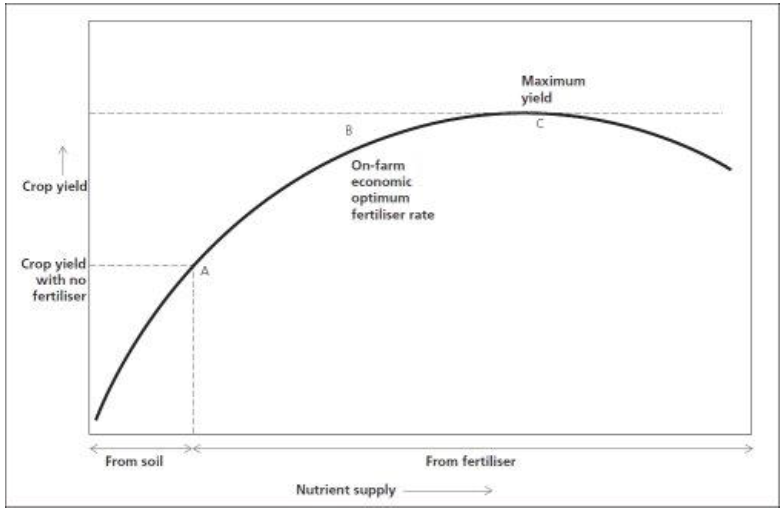In the 12 months up to October 2021 the price of fertiliser (AHDB) has increased as follows:
| Nutrient | Price per Tonne | Increase in 12 months |
|---|---|---|
| Ammonium Nitrate | 587 | 183% |
| Triple Super Phosphate | 521 | 113% |
| Muriate of Potash | 513 | 111% |
Prices continue to rise and at these levels serious thinking is required as to how much fertiliser we use in the coming season based on what will be a cost effective return. We need to get back to basics and consider the nutrient response curves and how this impacts on the decisions we need to make.
The need for Nitrogen for your crops
Provided that there is an adequate supply of water and other nutrients and soil structure is sound, nitrogen usually has the largest effect on crop growth.
The graph below shows the normal nitrogen response curve.

- Without applied nitrogen crop yield is low (A).
- As nitrogen level increases so does yield, up to the on farm economic optimum nitrogen rate (B).
This value is determined by the cost of the nitrogen relative to the value of the crop. The rate depends on the cost of the nitrogen and on the value of the crop (a breakeven ratio). RB209 recommendations are calculated using a typical breakeven ratio (i.e the crop yield in kg needed to pay for 1kg nitrogen).
Applications of nitrogen above this level will continue to increase yield up to a maximum (C), but this will not be cost effective and severely risks damaging the environment.
As a general rule RB209 recommendations are insensitive to changes in the value of the crop or the cost of the nitrogen fertiliser. But as we know this is not a normal year!
With prices for ammonium nitrate now being reported up to as high as £800/t, ADAS has been working on extending the RB209 recommendations to factor in cereal prices up to £350/t and ammonium nitrate prices at £863/t.
What this means in practise is that at wheat grain price of £200/t a rise in the ammonium nitrate price from £345/t to £863/t would see an N reduction in recommended applications of around 70kg N/ha. This would result in an approximate grain yield loss of around 0.6t/ha, but this would be the cost effective optimum.
It is absolutely essential that farmers factor in these price rises when deciding how much nitrogen to apply in the spring. In order to help farmers do this there is a Nitrogen Adjustment Fertiliser Calculator on the AHDB website which can be downloaded from: Nitrogen fertiliser adjustment calculator for cereals and oilseeds | AHDB
An example of how you should reduce your nitrogen rates on winter wheat at various prices of grain and fertiliser is given in the following table:
| Price of Ammonium Nitrate 34.5% | Wheat Price @ £150/t | Wheat Price @ £200/t | Wheat Price @ £250/t |
|---|---|---|---|
| £500/t | -50 kg | -25 kg | -10 kg |
| £600/t | -60 kg | -40 kg | -25 kg |
| £700/t | -70 kg | -50 kg | -35 kg |
| £800/t | -75 kg | -60 kg | -45 kg |
So far, the calculator only covers cereals and oilseeds, but ADAS are working on other arable crops, grassland and maize, and these will be available early in the New Year.
Manure, manure, manure (being polite!)
Slurry has been a headache for many farmesr this autumn, particularly concerning the Environment Agency’s new interpretation of the Farming Rules for Water and the ban on spreading manures in the autumn and on high phosphate soils.
However, with artificial nitrogen prices getting up to the £2/kg mark it is timely to remember the fertiliser value of manures on your farm and think about how you can best use them.
The following table shows the fertiliser value of your manure at current fertiliser prices:
| Manure | Value of N £/t |
Value of P £/t |
Value of K £/t |
Total Value |
|---|---|---|---|---|
| FYM | 12.00 | 3.62 | 6.84 | 22.46 |
| Slurry | 5.20 | 1.36 | 2.74 | 9.30 |
A dairy cow produces approximately 23t slurry per year, which now equates to £214 worth of fertiliser!!! So being mindful about where you put it to match crop nutrient need will not only save you buying fertiliser, but will also maximise your economic crop yields.
Of course in the first year not all the nutrients being applied are available to the growing crop, so you have to factor this in. And manure storage has to be considered. It is no good planning to apply lots of slurry to the growing crops in spring if you do not have enough storage to carry it over.
And as we are currently finding, securing planning permission for new slurry stores does not happen overnight!
Want to Maximise the Nutrients in your Manure this year?
We can help if you provide us with the following information.
- Recent soil analysis (fields should be tested every 4 years).
- Field details – size, soil type, in NVZ?, suitable for spreading manure?
- Cropping, manure and fertiliser applied last year.
- Planned cropping for this year.
- Details of animals on holding this winter.
- Details of manure stores on farm.
- Your normal plan of manure disposal.
100% independent, 100% for you.


